Ocelot
| Ocelot | |
|---|---|
_Zoo_Itatiba.jpg) | |
| Scientific classification | |
| Kingdom: | Animalia |
| Phylum: | Chordata |
| Class: | Mammalia |
| Order: | Carnivora |
| Suborder: | Feliformia |
| Family: | Felidae |
| Subfamily: | Felinae |
| Genus: | Leopardus |
| Species: | L. pardalis[2] |
| Binomial name | |
| Leopardus pardalis[2] | |
| Subspecies | |
|
See text | |
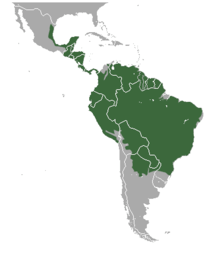 | |
| Range of the ocelot | |
| Synonyms[3] | |
|
Felis buffoni Brass, 1911 | |
The ocelot (Leopardus pardalis) /ˈɒsəlɒt/ is a wild cat native to the southwestern United States, Mexico, Central and South America. It is listed as Least Concern on the IUCN Red List as the population is estimated to comprise more than 40,000 mature individuals and is considered stable. Its fur was once regarded as particularly valuable, but legal trade of its fur ceased decades ago.[1]
In the United States, it inhabits southern Texas and southern Arizona.[4][5]
Taxonomy and phylogeny
The scientific name of the ocelot is Leopardus pardalis. It is a member of the genus Leopardus of the family Felidae.[2] The species was first described as Felis pardalis by the Swedish zoologist Carl Linnaeus in the 10th edition of Systema Naturae (1758); he placed it in the genus Felis along with the domestic cat, Eurasian lynx, jaguar, leopard, lion and tiger.[6] Following Linnaeus's description, several more ocelot subspecies have been proposed in the 19th and 20th centuries:[3][2]
- L. p. pardalis (Linnaeus, 1758), described from a Mexican specimen; synonyms include L. p. canescens, L. p. griffithii, L. p. griseus, L. p. ocelot and L. p. pictus.
- L. p. mitis (Cuvier, 1820) described from a specimen from Rio de Janeiro, Brazil. Synonyms include L. p. armillatus, L. p. brasiliensis, L. p. chibi-gouazou, L. p. chibiguazu, L. p. hamiltonii, L. p. maracaya and L. p. smithii.
- L. p. pseudopardalis (Boitard, 1842) was described from a specimen from Santa Marta, Colombia. L. p. sanctaemartae is a synonym.
- L. p. melanura (Ball, 1844) was described from a specimen from "British Guiana", which, according to British zoologist Reginald Innes Pocock, probably refers to Guyana. Synonyms include L. p. maripensis and L. p. tumatumari
- L. p. albescens (Pucheran, 1855) was described from a specimen from Brownsville, Texas. Synonyms include L. p. limitis and L. p. ludoviciana
- L. p. aequatorialis (Mearns, 1906) was described from a specimen from Talamanca canton in Costa Rica. L. p. mearnsi and L. p. minimalis are synonyms.
- L. p. pusaea Thomas, 1914 was described from a specimen from Guayas Province in coastal Ecuador.
- L. p. nelsoni (Goldman, 1925) was described from a specimen from Manzanillo in Mexico.
- L. p. sonoriensis (Goldman, 1925) was described from a specimen from the Mayo River region in Mexico.
- L. p. steinbachi Pocock, 1941 was described from a specimen from Buena Vista in Bolivia.
In 2017, the Cat Classification Task Force of the Cat Specialist Group provisionally recognized only two of the above as valid subspecies, namely L. p. pardalis and L. p. mitis.[7]
According to studies on felid taxonomy and evolution, the phylogenetic relationships of the ocelot are considered as follows:[8][9]
|
| ||||||||||||||||||||||||||||||||||||||||||||||||||||||||||||||||||||||||||||||||||||||||
Characteristics
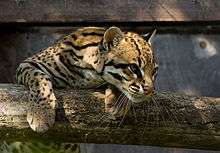
The ocelot's fur is extensively marked with solid black markings on a creamy, tawny, yellowish, reddish grey or grey background colour. The spots on head and limbs are small, but markings on the back, cheeks and flanks are open or closed bands and stripes. A few dark stripes run straight from the back of the neck up to the tip of the tail. Its neck and undersides are white, the insides of the legs are marked with a few horizontal streaks. Its round ears are marked with a bright white spot.[10] Its fur is short, about 0.8 cm (0.31 in) long on the belly, but with longer, about 1 cm (0.39 in) long guard hairs on the back. It has 28 to 30 teeth, with the dental formula 3.1.2–3.13.1.2.1.[3] Its eyes are brown but reflect golden when illuminated.[11] It is a medium sized cat with a head-and-body length of between 55 and 100 cm (22 and 39 in) and a 25.5 to 41 cm (10.0 to 16.1 in) long tail. Females weigh 6.6–11.3 kg (15–25 lb) and males 7–15.5 kg (15–34 lb).[10][12] Its spoor measures nearly 2 cm × 2 cm (0.79 in × 0.79 in).[13]
English naturalist Richard Lydekker commented that the ocelot is "one of the most difficult members of the feline family to describe". In 1929, wildlife author Ernest Thompson Seton described the ocelot's coat as "the most wonderful tangle of stripes, bars, chains, spots, dots and smudges ... which look as though they were put on as the animal ran by."[10]
The ocelot can be easily confused with the margay, but differs in being twice as heavy, having a greater head-and-body length, a shorter tail, smaller eyes relative to the size of the head, and different cranial features.[10][14] It is similar in size as the bobcat. Larger individuals have occasionally been recorded.[15] The jaguar is notably larger and heavier, and has rosettes instead of spots and stripes.[16]
Ecology and behavior
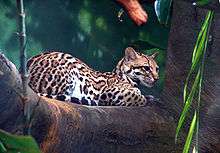
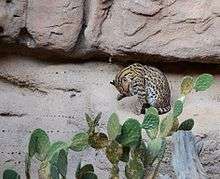
The ocelot is usually solitary and active around twilight and at night. It scent-marks its territory by spraying urine. The territories of males are 3.5–46 km2 (1.4–17.8 sq mi) large, while those of females cover 0.8–15 km2 (0.31–5.79 sq mi). Territories of females rarely overlap, whereas the territory of a male includes those of two to three females. Social interaction between sexes is minimal, though a few adults have been observed together even in non-mating periods, and some juveniles interact with their parents.[10] In Peru’s Cocha Cashu Biological Station, radio-collared individuals rested during the day in dens below large trees or other sheltered sites on the ground. They started to be active earliest in the late afternoon and moved between 3.2 and 17 hours until latest dawn, when they returned to their dens. Their usual pace of walking was about 300 m (980 ft) per hour when hunting. They moved up to 1.4 km (0.87 mi) per hour when heading to a known kill site or patrolling their territory.[17]
Data from camera trapping studies confirm that several ocelot individuals deposit scat in one or several communal sites, called latrines, suggesting that these sites have a social function.[18][19][20]
Ocelot densities vary between study sites, habitats and seasons from 2.3 individuals per 100 km2 (39 sq mi) in Belize's Chiquibul National Park to 40 individuals per 100 km2 (39 sq mi) in Venezuelan Llanos.[21][22] A density of 60 individuals per 100 km2 (39 sq mi) was recorded in a transitional chaco-Chiquitano forest in Bolivia's Kaa Iya National Park. It is thought that ocelot density is lower in areas with less rainfall.[23] In Barro Colorado Island, 28 ocelots were identified during a camera trapping survey in 2012, and 55 individuals based on genetic analysis of scat collected in latrines. Results indicate that the island holds an ocelot density of 1.59–1.74/km2 (4.1–4.5/sq mi), the highest one recorded to date. This is probably an effect of high prey availability, few large predators, and increased protection from poaching.[24][25]
Diet and hunting
Ocelots are carnivores and prey on small mammals, such as armadillos, opossums and rabbits, rodents, small birds, fish, insects and reptiles.[10] According to studies, primates prevail in the diet of ocelots in southeastern Brazil,[26] and iguanas are the main prey of Mexican ocelots.[27] An ocelot typically preys on animals that weigh less than 1 kilogram (2.2 lb). It rarely targets large animals such as deer and peccaries. An ocelot requires 600–800 grams (21–28 oz) of food every day to satisfy its energy requirements.[10] The composition of the diet may vary by season; in Venezuela, ocelots were found to prefer iguanas and rodents in the dry season and then switch to land crabs in the wet season.[22] A study showed that ocelots are similar to margays and oncillas in dietary preferences, but the oncilla focuses on tree-living marsupials and birds while the margay is not as selective.[28]
Ocelots have been observed to follow scent trails to acquire prey. They walk at a speed of about 300 m/h (0.2 mph) on the lookout for prey; and at a speed of 800–1,400 m/h (0.5–0.9 mph) to a known kill site.[17] Or they wait for 30 to 60 minutes at a certain place, and then move on to a different place when unsuccessful. They tend to eat the kill immediately, and remove feathers before eating birds.[10]
Reproduction
Both male and female ocelots produce a long-range "yowl" in the mating season as well as short-range vocalizations like "meow"s.[29] Ocelots may mate at any time of the year, and the time when peaks occur varies geographically – peaks have been observed during autumn and winter in Mexico and Texas, and during autumn in Argentina and Paraguay. Oestrus lasts four to five days, and recurs every 25 days in a non-pregnant female.[12] A study in southern Brazil showed that sperm production in ocelots, margays as well as oncillas peaks in summer.[30] Observations of captive ocelots suggest that a mating pair will spend more time together; both will scent-mark extensively and may even eat less.[3]
A litter of one to three is born after a gestational period of 79 to 83 days. Births take place in dens, usually located in dense vegetation. A newborn kitten weighs 200–340 grams (7.1–12.0 oz).[10][12] A study in southern Texas showed that a mother will use two to three dens, and keep a litter in a den for 13 to 64 days.[31] The eyes open 15 to 18 days after birth. Kittens begin to leave the den at three months, but remain with their mother for up to two years, before dispersing to establish their own territory. In comparison to other felids, ocelots have a relatively longer duration between births and a narrow litter size. Ocelots live for up to 20 years in captivity.[10]
Distribution and habitat
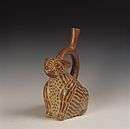
The ocelot is distributed extensively over South America, including the Margarita and Trinidad islands, Central America, Mexico and a small population in southern Texas.[2][32][33] Countries in this range are: Argentina, Belize, Bolivia, Brazil, Colombia, Costa Rica, Ecuador, El Salvador, Guatemala, Guyana, Honduras, Mexico, Nicaragua, Panama, Paraguay, Peru, Suriname, Trinidad and Tobago, the United States and Venezuela. The cat is likely extinct in Uruguay.[1] It inhabits tropical forest, thorn forest, mangrove swamps and savanna at elevations up to 1,200 m (3,900 ft). It prefers areas with relatively dense vegetation cover, but occasionally hunts in more open areas at night.[10] In Mexico's Sierra de Manantlán Biosphere Reserve, four ocelots were recorded at elevations of 1,934 to 2,059 m (6,345 to 6,755 ft) in cloud and pine forests, and also in a patch of wild perennial teosinte.[34]
The ocelot once inhabited the chaparral thickets of the Gulf Coast of south and eastern Texas, and could be found in Arizona, Louisiana, and Arkansas.[35] In the United States, it now ranges only in several small areas of dense thicket in South Texas and is rarely sighted in Arizona. On November 7, 2009, an ocelot was photographed in the mountains of Cochise County, Arizona. This was the first such verifiable evidence of the feline's presence in the state.[36] In February 2011, the Arizona Game and Fish Department confirmed the sighting of another ocelot in the Huachuca Mountains of southern Arizona.[37] Most surviving Texas ocelots are in the shrublands remaining at or near the Laguna Atascosa National Wildlife Refuge near Brownsville, where only 30–35 animals remain.[38]
Threats
.jpg)
The destruction of habitat is the main threat to ocelot survival. In addition, it is sought by poachers for the illegal trade in body parts and skin, and killed in retaliation for hunting poultry.[1] The remnant U.S. ocelot population in south Texas has declined from 80–120 individuals in 1995 to fewer than 50 by 2013, with about half of ocelot deaths resulting from automobile accidents.[39][40]
Etymology
The name "ocelot" comes from the Nahuatl word ōcēlōtl (pronounced [oːˈseːloːt͡ɬ]), which generally refers to the jaguar rather than the ocelot.[41][42][43] Another possible origin for the name is the Latin cellatus ("having little eyes" or "marked with eye-like spots"), in reference to the cat's spotted coat.[10] Other vernacular names for the ocelot include cunagaro (Venezuela), gato onza (Argentina), gato tigre (Panama), heitigrikati (Suriname), jaguatirica (Brazil), manigordo (Costa Rica, Panama and Venezuela), maracaja (Brazil), mathuntori, ocelote, onsa, pumillo, tiger cat (Belize), tigrecillo (Bolivia) and tigrillo (Colombia, Ecuador, Guatemala and Peru).[3][44]
As pets
Like many wild cats, ocelots are occasionally kept as pets. Salvador Dalí frequently traveled with his pet ocelot Babou,[45] even bringing it aboard the luxury ocean liner SS France.[46]
Opera singer Lily Pons was also known to have kept an ocelot ("Ita") at her NYC apartment, later donating it to a local zoo.[47]
Musician Gram Parsons kept an ocelot as a pet in the backyard swimming pool area of his family's Winter Haven, Florida, home, during his teens, in the mid-1960s.[48]
The Moche people of ancient Peru worshiped animals and often depicted the ocelot in their art.[49]

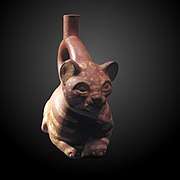
References
- 1 2 3 4 Paviolo, A.; Crawshaw, P.; Caso, A.; de Oliveira, T.; Lopez-Gonzalez, C.A.; Kelly, M.; De Angelo, C. & Payan, E. (2015). "Leopardus pardalis". IUCN Red List of Threatened Species. Version 2017-3. International Union for Conservation of Nature. doi:10.2305/IUCN.UK.2015-4.RLTS.T11509A50653476.en
- 1 2 3 4 5 Wilson, D.E.; Reeder, D.M., eds. (2005). Mammal Species of the World: A Taxonomic and Geographic Reference (3rd ed.). Johns Hopkins University Press. p. 539. ISBN 978-0-8018-8221-0. OCLC 62265494.
- 1 2 3 4 5 Murray, J.L.; Gardner, G.L. (1997). "Leopardus pardalis". Mammalian Species (548): 1–10. doi:10.2307/3504082. JSTOR 3504082.
- ↑ U.S. Fish and Wildlife Service. 2010. Draft Ocelot (Leopardus pardalis) Recovery Plan, First Revision. Fish and Wildlife Service, Southwest Region, Albuquerque, New Mexico.
- ↑ Stangl Jr, F. B. and Young, J. H (2011). "The ocelot (Leopardus pardalis) in northern Texas, with comments on its northern biogeography". Western North American Naturalist. 71 (3): 412–417. doi:10.3398/064.071.0309.
- ↑ Linnaeus, C. (1758). "Felis pardalis". Systema Naturæ. I (10th ed.). Holmiae: Laurentius Salvius. p. 42.
- ↑ Kitchener, A. C.; Breitenmoser-Würsten, C.; Eizirik, E.; Gentry, A.; Werdelin, L.; Wilting, A.; Yamaguchi, N.; Abramov, A. V.; Christiansen, P.; Driscoll, C.; Duckworth, J. W.; Johnson, W.; Luo, S.-J.; Meijaard, E.; O'Donoghue, P.; Sanderson, J.; Seymour, K.; Bruford, M.; Groves, C.; Hoffmann, M.; Nowell, K.; Timmons, Z.; Tobe, S. (2017). "A revised taxonomy of the Felidae: The final report of the Cat Classification Task Force of the IUCN Cat Specialist Group" (PDF). Cat News (Special Issue 11).
- ↑ Johnson, W.E.; Eizirik, E.; Pecon-Slattery, J.; Murphy, W.J.; Antunes, A.; Teeling, E. & O'Brien, S.J. (2006). "The Late Miocene radiation of modern Felidae: A genetic assessment". Science. 311 (5757): 73–77. doi:10.1126/science.1122277. PMID 16400146.
- ↑ Werdelin, L.; Yamaguchi, N.; Johnson, W.E.; O'Brien, S.J. (2010). "Phylogeny and evolution of cats (Felidae)". In Macdonald, D.W.; Loveridge, A.J. Biology and Conservation of Wild Felids (PDF) (Reprint ed.). Oxford, UK: Oxford University Press. pp. 59–82. ISBN 978-0-19-923445-5.
- 1 2 3 4 5 6 7 8 9 10 11 12 Sunquist, M.; Sunquist, F. (2002). "Ocelot Leopardus pardalis (Linnaeus, 1758)". Wild Cats of the World. Chicago, US: University of Chicago Press. pp. 120–129. ISBN 978-0-226-77999-7.
- ↑ Cisin, C. (1967). Especially ocelots. Amagansett, New York: Harry G. Cisin.
- 1 2 3 Nowak, R.M. (1999). "Felis pardalis (ocelot)". Walker's Mammals of the World (6th ed.). Baltimore, US: Johns Hopkins University Press. pp. 816–817. ISBN 978-0-8018-5789-8.
- ↑ Murie, O.J. (1998). A Field Guide to Animal Tracks (2nd ed.). New York, US: Houghton Mifflin Co. p. 123. ISBN 978-0-395-91094-8.
- ↑ Bowers, N.; Bowers, R.; Kaufman, K. (2007). Kaufman Field Guide to Mammals of North America. New York, US: Houghton Mifflin Co. p. 140. ISBN 978-0-618-95188-8.
- ↑ Moreno, R.S.; Kays, R.W.; Samudio, R. (2006). "Competitive release in diets of ocelot (Leopardus pardalis) and puma (Puma concolor) after jaguar (Panthera onca) decline" (PDF). Journal of Mammalogy. 87 (4): 808–816. doi:10.1644/05-MAMM-A-360R2.1. Archived from the original (PDF) on 2011-03-04.
- ↑ Burt, W.H. (1976). A Field Guide to the Mammals: North America North of Mexico (3rd ed.). Boston, US: Houghton Mifflin Co. pp. 78–79. ISBN 978-0-395-91098-6.
- 1 2 Emmons, L.H. (1988). "A field study of ocelots Felis pardalis in Peru" (PDF). Revue d'Écologie. 43 (2): 133–157.
- ↑ Moreno, R. and Giacalone, J. (2006). "Ecological data obtained from latrine use by ocelots (Leopardus pardalis) on Barro Colorado Island, Panama". Tecnociencia. 8 (1): 7−21.
- ↑ Rodgers, T.W., Giacalone, J., Heske, E.J., Pawlikowski, N.C. and Schooley, R.L. (2015). "Communal latrines act as potentially important communication centers in ocelots Leopardus pardalis". Mammalian Biology-Zeitschrift für Säugetierkunde. 80 (5): 380−384.
- ↑ King, T.W., Salom-Pérez, R., Shipley, L.A., Quigley, H.B. and Thornton, D.H. (2016). "Ocelot latrines: communication centers for Neotropical mammals". Journal of Mammalogy. 98 (1): 106−113.
- ↑ Dillon, A. and Kelly, M.J. (2007). "Ocelot Leopardus pardalis in Belize: the impact of trap spacing and distance moved on density estimates". Oryx. 41: 469–477.
- 1 2 Ludlow, M.E.; Sunquist, M. (1987). "Ecology and behavior of ocelots in Venezuela". National Geographic Research. 3 (4): 447–461.
- ↑ Maffei, L.; Noss, A.J.; Cuéllar, E.; Rumiz, D.I. (2005). "Ocelot (Felis pardalis) population densities, activity, and ranging behaviour in the dry forests of eastern Bolivia: data from camera trapping" (PDF). Journal of Tropical Ecology. 21 (3): 349–353. doi:10.1017/S0266467405002397.
- ↑ Rodgers, T.W.; Giacalone, J.; Heske, E.J.; Janečka, J.E.; Phillips, C.A.; Schooley, R.L. (2014). "Comparison of noninvasive genetics and camera trapping for estimating population density of ocelots (Leopardus pardalis) on Barro Colorado Island, Panama". Tropical Conservation Science. 7 (4): 690–705. doi:10.1177/194008291400700408.
- ↑ Hance, J. (2014). "Ocelots live in super densities on Barro Colorado Island". Mongabay.
- ↑ Bianchi, R.C.; Mendes, S.L. (2007). "Ocelot (Leopardus pardalis) predation on primates in Caratinga Biological Station, southeast Brazil". American Journal of Primatology. 69 (10): 1173–8. doi:10.1002/ajp.20415. PMID 17330310.
- ↑ Meza, A.V.; Meyer, E.M.; Gonzalez, C.A.L. (2002). "Ocelot (Leopardus pardalis) food habits in a tropical deciduous forest of Jalisco, Mexico". The American Midland Naturalist. 148 (1): 146–54. doi:10.1674/0003-0031(2002)148[0146:OLPFHI]2.0.CO;2.
- ↑ Wang, E. (2002). "Diets of ocelots (Leopardus pardalis), margays (L. wiedii), and oncillas (L. tigrinus) in the Atlantic rainforest in southeast Brazil". Studies on Neotropical Fauna and Environment. 37 (3): 207–12. doi:10.1076/snfe.37.3.207.8564.
- ↑ Peters, G. (1984). "On the structure of friendly close range vocalizations in terrestrial carnivores (Mammalia: Carnivora: Fissipedia)". Zeitschrift für Säugetierkunde. 49 (3): 157–182.
- ↑ Morais, R.N.; Mucciolo, R.G.; Gomes, M.L.F.; Lacerda, O.; Moraes, W.; Moreira, N.; Graham, L.H.; Swanson, W.F.; Brown, J.L. (2002). "Seasonal analysis of semen characteristics, serum testosterone and fecal androgens in the ocelot (Leopardus pardalis), margay (L. wiedii) and tigrina (L. tigrinus)". Theriogenology. 57 (8): 2027–41. doi:10.1016/S0093-691X(02)00707-0. PMID 12066863.
- ↑ Laack, L.L.; Tewes, M.E.; Haines, A.M.; Rappole, J.H. (2005). "Reproductive life history of ocelots Leopardus pardalis in southern Texas". Acta Theriologica. 50 (4): 505–14. doi:10.1007/BF03192643.
- ↑ Ocelot. The Animal Files. Retrieved on 2012-04-10.
- ↑ "News Release, March 2014 – Laguna Atascosa – U.S. Fish and Wildlife Service". Fws.gov. Retrieved 2014-04-21.
- ↑ Arzate, E. M., Dávalos, L. I. I., and González, C. A. L. (2011). "High elevation records of ocelots (Leopardus pardalis) in Jalisco, Mexico". Mammalia. 75: 387−388.
- ↑ Mammals: Ocelot The San Diego Zoo
- ↑ "Rare ocelot photographed in southern Arizona". Associated Press. 2010.
- ↑ "Rare ocelot observed in southern Arizona". Arizona Game and Fish Department. 2011.
- ↑ "Ocelot (Leopardus pardalis)". Texas Parks and Wildlife Department. Retrieved 2013-10-18.
- ↑ Ocelot (PDF) (Report). Texas Parks and Wildlife Department. Retrieved 2013-10-18.
- ↑ Sinclair, S. (2013). "Current Sightings: Plight of the ocelot: Endangered cat's future uncertain". The Coastal Current. Retrieved 2013-10-18.
- ↑ "ocelot, n.". Oxford English Dictionary. 2004.
- ↑ K., Frances (1983). An Analytical Dictionary of Nahuatl. Austin, Texas: University of Texas Press. p. 176.
- ↑ L., James (2001). Nahuatl as Written: Lessons in Older Written Nahuatl, with Copious Examples and Texts. Stanford, California: Stanford University Press. p. 228.
- ↑ Ojasti, J. (1996). Wildlife Utilization in Latin America: Current Situation and Prospects for Sustainable Management. Rome: Food and Agriculture Organization. pp. 82–4. ISBN 978-92-5-103316-6.
- ↑ Dali with Capitain Moore and Ocelot – Vintage photo. Ecademy.com. Retrieved on 2011-09-15.
- ↑ Huggler, Justin. "Chic ship too toxic for scrapping". ssMaritime.com. Archived from the original on 2007-02-21.
- ↑ Twomey, Bill (February 20, 2015). "Met Opera's Lily Pons leaves pet at Bronx Zoo". Bronx Times Reporter. p. 48.
- ↑ "Return of the grievous angel: New bio of Gram Parsons offers tragic insights" (PDF). Austin American Statesman. Archived from the original (PDF) on July 16, 2011. Retrieved 2009-11-02.
- ↑ Museo Arqueologico Rafael Larco Herrera (1997). Katherine Berrin, ed. The Spirit of Ancient Peru: Treasures from the Museo Arqueologico Rafael Larco Herrera. New York City: Thames and Hudson. ISBN 978-0-500-01802-6.
External links
| Wikimedia Commons has media related to: |
| Wikispecies has information related to Leopardus pardalis |
| Look up ocelot in Wiktionary, the free dictionary. |
